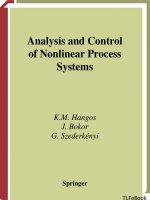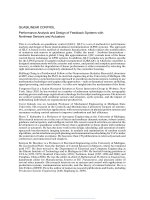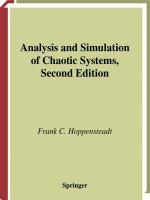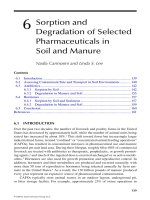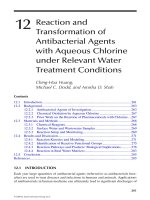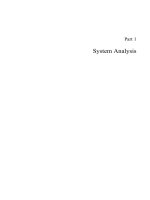Analysis and Control of Linear Systems - Chapter 12 pptx
Bạn đang xem bản rút gọn của tài liệu. Xem và tải ngay bản đầy đủ của tài liệu tại đây (413.39 KB, 26 trang )
Chapter 12
Predictive Control
The developments presented in this chapter aim to cover the main ideas of
predictive control and then to indicate the details of the analytical minimization of
the criterion for two individual structures enabling the elaboration of the equivalent
polynomial regulator. The choice of adjustment parameters will also be analyzed,
providing some simple rules that guarantee the corrected system good stability and
robustness.
12.1. General principles of predictive control
Predictive control is based on some relatively old and intuitive ideas [RIC 78],
but it has been developed as an advanced control technique mainly since the 1980s.
This development was done mainly according to two privileged main lines:
– generalized predictive control (GPC) by Clarke (1985);
– functional predictive control (FPC) by Richalet (1987).
The philosophy of predictive control lies on the definition of five great ideas,
common to all the methods.
12.1.1. Anticipative aspect
This anticipative effect is obtained by using explicit knowledge on the evolution
of the trajectory to be followed in the future (necessary knowledge required at least
Chapter written by Patrick BOUCHER and Didier DUMUR.
374 Analysis and Control of Linear Systems
on the horizon of some points beyond the present moment). This constraint which
makes it possible to make good use of all the resources of the method, necessarily
restricts the application field to the control of the systems for which the trajectory to
follow is perfectly known and stored pixel by pixel in the computer. It is the case of
the numerical control of machine-tools (cutting the pieces), of the control of robots
arms, of monitoring the temperature profile of the applications in home automation,
etc.
12.1.2. Explicit prediction of future behavior
The method requires the definition of a numerical model of the system, which
makes it possible to predict the future behavior of the system. This discrete model
results mainly from a preliminary offline identification. This feature makes it
possible to classify predictive control in the big family of Model Based Control
(MBC).
12.1.3. Optimization by minimization of a quadratic criterion
The optimization which makes it possible to obtain the control law is done by
minimizing a quadratic criterion with finite horizon referring to the errors of future
prediction, the variance between the predicted output of the system and the future
setting or the reference trajectory inferred from this setting.
12.1.4. Principle of the sliding horizon
The elaboration of a sequence of future controls results from the preceding
minimization, which is optimal in what the quadratic criterion is concerned, out of
which only the first value is applied to the system and the model.
The preceding steps are then repeated during the following sampling period
according to the principle of sliding horizon, as seen in Figure 12.1.
Predictive Control 375
Figure 12.1. Principle of sliding horizon
The objective of the polynomial predictive regulator obtained by minimizing the
criterion is that the predicted output joins the setting or the reference trajectory on a
given prediction horizon. The principles that we have just mentioned make it
possible to establish the operation diagram in Figure 12.2.
Figure 12.2. Operation principle of a predictive algorithm
Hence, the principle of the sliding horizon means that only the control at the
present moment u(t) is applied on the system. Therefore, it is possible to limit the
number of estimated values of the sequence.
376 Analysis and Control of Linear Systems
12.2. Generalized predictive control (GPC)
12.2.1. Formulation of the control law
The objective of this section is to indicate the fundamental points of the
predictive structure considered [CLA 87a, CLA 87b], in the monovariable case,
from the mathematical translation of the preceding general concepts up to the
obtaining the equivalent polynomial regulator.
12.2.1.1. Definition of the numerical model
All the forms are allowable for the model but the input/output polynomial
approach by transfer functions is preferred.
Traditionally the model is represented as CARIMA (Controlled AutoRegressive
Integrated Moving Average):
)(
)(
)1()()()(
1
11
−
−−
∆
+−=
q
t
tuqBtyqA
ξ
[12.1]
where
11
1)(
−−
−=∆ qq , )(tu and )(ty are the input and output of the model, )(t
ξ
is a centered white noise,
1−
q is the delay operator and )(
1−
qA and )(
1−
qB are
polynomials defined by:
⎪
⎩
⎪
⎨
⎧
+++=
+++=
−
−−
−
−−
b
b
a
a
n
n
n
n
qbqbbqB
qaqaqA
)(
1)(
1
10
1
1
1
1
""
""
[12.2]
This model, which is also called incremental model, introduces an integral action
and makes it possible to undo all the static errors with respect to the input or step
function interference.
12.2.1.2. Optimal predictor
The predicted output
)/( tjty + is traditionally decomposed into a free and
forced response [FAV 88], including a polynomial form meant to properly conclude
the final polynomial synthesis:
11 1 1
(/) ()() ()(1) ()( 1)()()
forced response
free response
jj j j
yt j t F q yt H q ut G q ut j J q t j
∆∆ ξ
−− − −
+= + −+ +−+ +
[12.3]
Predictive Control 377
The unknown polynomials
jjjj
JHGF ,,,
are single solutions of Diophantus
equations, which are obtained by equality of the inputs and output of transfer
functions of equations [12.1] and [12.3] and they are solved recursively:
)()()()(
1)()()()(
1111
1111
−−−−−
−−−−−
=+
=+∆
qJqBqHqqG
qFqqJqAq
jj
j
j
j
j
j
[12.4]
with:
()
[]
()
[]
1 degree
1 degree
1
1
−=
−=
−
−
jqG
jqJ
j
j
()
[]
()
[]
()
[]
()
[]
1 degree degree
degree degree
11
11
−=
=
−−
−−
qBqH
qAqF
j
j
The set of calculations may be done in real-time off loop. The optimal predictor
is finally defined by considering that the best noise prediction in the future is its
mean (here supposed as zero), let us suppose that:
−− −
+= + ∆−+ ∆+−
11 1
ˆ
(/) ()() ()(1) ()( 1)
jj j
yt j t F q yt H q ut G q ut j
[12.5]
12.2.1.3. Definition and minimization of the quadratic criterion
The control law is obtained by minimizing a quadratic criterion pertaining to
future errors with a weighting term on the control:
λ
==
=+−++∆+−
∑∑
2
1
22
1
ˆ
[( ) ( )] ( 1)
u
N
N
jN j
Jytjwtj utj [12.6]
with:
∆+≡()0 ut j for ≥
u
jN.
The criterion requires the definition of four adjustment parameters:
–
1
N : minimal prediction horizon;
–
2
N : maximal prediction horizon;
–
u
N : prediction horizon on the control;
–
λ
: weighting coefficient on the control.
378 Analysis and Control of Linear Systems
12.2.1.4. Synthesis of the equivalent polynomial RST regulator
The minimization of the criterion is based on writing the prediction equation
[12.5] and the cost function [12.6] in a matrix form, such as:
=+ +∆−yuif ih
ˆ
G () (1)yt ut
[]
[]
uuihifu
ihifu
~~
w)1( )(
~
G
w)1( )(
~
G
T
T
λ+−−∆++
−−∆++=
tuty
tutyJ
[12.7]
with:
[]
[]
[]
T
T
11
T
11
)1()(
~
)()(
)()(
21
21
−+∆∆=
=
=
−−
−−
u
NN
NN
Ntutu
qHqH
qFqF
"
"
"
u
ih
if
−
++
+
−−+
⎡
⎤
⎢
⎥
⎢
⎥
⎢
⎥
=
⎢
⎥
⎢
⎥
⎢
⎥
⎢
⎥
⎣
⎦
""
""
""""
"
11
11
11
11
22 2
22 2
1
11
1
11
G
u
NN
NN
NN
NN
NN N
NN NN
gg
gg
gg g
The analytical minimization of the criterion leads to an optimal sequence of
future controls:
[
]
=− −∆−u N if ih
w () (1)
opt
yt ut [12.8]
with:
λ
−
⎡
⎤
⎡⎤
=+ =
⎢
⎥
⎣⎦
⎣
⎦
NI nn"
T1TTTT
1
GG G
u
u
N
N
[]
⎡⎤
=∆ ∆ + −
⎣⎦
=+ +
u
"
"
T
T
12
() ( 1)
w( ) ( )
opt opt u opt
ut ut N
wt N wt N
Predictive Control 379
Traditionally, in a predictive control, only the first value of the sequence,
equation [12.8] is applied to the system, according to the principle of the sliding
horizon:
[]
wihifn −−∆+−−= )1( )( )1()(
T
1
tutytutu
optoptopt
[12.9]
Based on the above relation, it is finally possible to obtain the polynomial
representation of the equivalent regulator as indicated in Figure 12.3. This traditional
RST structure enables the implementation of the control law by a simple
difference equation:
)()()()()()(
11
twqTtyqRtuqS +−=∆
−−
[12.10]
The three polynomials have the following form:
[]
12
1T1 1 1
1
1T 1 1
1
TT
12
( ) (1 ) degree ( ) degree ( )
( ) degree ( ) degree ( )
( ) degree ( )
NN
Sq q Sq Bq
Rq Rq Aq
Tq q q Tq N
−− − −
−−−
⎡
⎤⎡⎤
=+ =
⎣
⎦⎣⎦
⎡
⎤⎡⎤
==
⎣
⎦⎣⎦
⎡⎤
==
⎣⎦
nih
nif
n
"
Figure 12.3. Structure of the equivalent polynomial regulator
We observe that polynomial )(qT encloses the non-causal structure (positive
power of
q ) inherent to the predictive control.
The interest resulted from the RST representation (actually very general because
any numerical control law can be modeled this way [LAN 88]) is that, finally, the
real-time loop proves to take little calculation time as the control applied to the
system is calculated through a simple difference equation [12.10]. The three
380 Analysis and Control of Linear Systems
polynomials R, S, T are actually elaborated offline and uniquely defined as soon as
the four adjustment parameters are chosen.
Consequently, this type of control favors the selection of short sampling periods
and it proves to be well-adapted to the control of fast electro-mechanical systems
(machine-tool, high-speed machining, etc.).
Another major interest in the RST structure pertains to the study of stability of
the corrected loop and thus the characterization of stability of the elaborated
predictive control, which is from that moment on possible for a set of parameters of
the fixed criterion. This study is examined in the following section.
12.2.2. Automatic synthesis of adjustment parameters
The definition of the quadratic criterion [12.6] showed that the user must set four
adjustment parameters. However, this choice of parameters proves to be difficult for
a person who is not a specialist because there are no empirical relations which make
it possible to relate these parameters to traditional “indicators” in control such as
stability margins or a bandwidth.
Based on the study of a great number of single-variable systems, it is however
possible to issue some “rules” based on the traditional criteria of stability and
robustness [BOU 92] that we summarize.
12.2.2.1. Criterion of stability and robustness
First of all, the objectives of stability are related to the study in Bode, Black or
Nyquist planes of the transfer function of the open loop corrected by the predictive
regulator:
)()()(
)()(
)(
111
111
1
−−−
−−−
−
∆
=
qqSqA
qRqBq
qH
bo
[12.11]
It is generally agreed that a “good” adjustment is characterized by:
– a phase margin
ϕ
∆ higher to 45°;
– a minimal gain margin
∆G from 6 to 8 dB (decibels).
Predictive Control 381
The objectives of robustness are linked to the calculation of the delay margin
dB) 0at frequency angular gap rad,in (
c
ωϕωϕτ
∆∆=∆
c
[12.12]
to the study, in the scalar plane, of the direct sensitivity functions
d
σ
and
complementary sensitivity functions
c
σ
:
)()()()()(
)()()(
111111
111
−−−−−−
−−−
+∆
∆
=
qRqBqqqSqA
qqSqA
d
σ
[12.13]
)()()()()(
)()(
111111
111
−−−−−−
−−−
+∆
=
qRqBqqqSqA
qRqBq
c
σ
[12.14]
It is generally agreed that a “good” adjustment is characterized by:
– a delay margin higher than a sampling period;
– a direct sensitivity function of a module lower than 6 dB;
– a complementary sensitivity function of a module lower than 3 dB.
12.2.2.2. Selection procedure of the criterion parameters
From the criteria formulated above with the help of the traditional tools of scalar
Automation, it is possible to choose the sets of satisfactory adjustment parameters:
–
1
N : prediction horizon lower on the output. The product
e
TN
1
(
e
T sampling
period ) is chosen as equal to the pure delay of the system;
–
2
N : prediction horizon higher on the output. The product
e
TN
2
is limited by
the value of the response time. The bigger
2
N is, the more stable and slower the
corrected system becomes;
–
u
N : prediction horizon on the control. Choosing
u
N equal to 1 simplifies the
calculation and does not penalize the stability margins (on the contrary, a higher
value tends to decompose the phase margin);
–
λ
: weighting coefficient on the control. This parameter is related to the gain of
the system, through the empirical relation:
)(tr
T
GG=
opt
λ
(G matrix described in 12.2.1) [12.15]
382 Analysis and Control of Linear Systems
The choice of parameters is frequently limited to a bi-dimensional search (
2
N
and
λ
) ending with the selection of a “good” adjustment.
12.2.3. Extension of the basic version
Based on the preceding easy version, several derived strategies were developed,
which made it possible to recognize:
– closed loop pre-specified dynamics (structure of multiple reference models);
– several variables to control (cascade structure);
– constraints imposed on the input and output signals.
12.2.3.1. Structure of multiple reference models
The aim of this predictive structure of multiple reference models is double.
Firstly, it makes it possible to impose a reference trajectory through a stable pursuit
of a model determined by the user who tones down the conformity with the setting.
This pursuit model imposes the dynamics of the looped system (input/output
behavior) and it may be considered as a pole placement.
It is also a matter of weakening the quick control variations that we can
sometimes recognize through the preceding algorithm, by trying to recreate the
reasonable reference control that must be applied to the system in order to obtain, at
the output, the reference trajectory and by creating in the criterion a minimization on
the control error and not only on the control.
The digital model of prediction is defined here again as CARIMA:
)(
)(
)1()()()(
1
11
−
−−
∆
+−=
q
t
tuqBtyqA
ξ
[12.16]
The pursuit model chosen by the user makes it possible to specify the reference
trajectory
)(ty
r
that the output of the system will have to follow:
)()()()(
111
twqBqtyqA
rrr
−−−
= [12.17]
where:
)()()(
111 −−−
= qPqBqB
r
.
Predictive Control 383
)(
1−
qP is conceived in such a way as to insure the asymptotical behavior:
)()( ∞=∞ wy
r
Thus, for a step function setting, we can choose:
Cte
)1(
)1(
)(
1
==
−
B
A
qP
r
)(
1−
qA
r
is generally a second degree polynomial making it possible to impose a
desired response time as well as an adapted damping coefficient.
Coupled to the reference trajectory
)(ty
r
, a reference control )(tu
r
, which is
allowed by the system, is equally defined, the two trajectories being related by the
relation:
)()()()(
111
tuqBqtyqA
rr
−−−
= [12.18]
In order to avoid the reverse of the model and the stability problems related to
polynomial
)(
1−
qB that may result, equation [12.18] can be formulated again based
on relation [12.17] by:
)()()()()(
111
twqPqAtuqA
rr
−−−
= [12.19]
Figure 12.4 sums up the principle of this structure with reference models [IRV
86].
Figure 12.4. Principle of GPC/MRM algorithm
384 Analysis and Control of Linear Systems
The cost function is henceforth a weighted sum affecting the squares of the
output predicted errors and the squares of the future control error increments:
∑∑
==
−+++=
u
N
j
u
N
Nj
y
jtjtJ
1
22
)1()(
2
1
ελε
[12.20]
with:
ε
+≡()
0
u
tj for ≥
u
jN and:
⎩
⎨
⎧
+∆−+∆=+
+−+=+
)()()(
)()(
ˆ
)(
jtujtujt
jtyjtyjt
ru
ry
ε
ε
.
Based on relations [12.16], [12.17] and [12.18], we notice that, on the one hand,
the increments of control errors and, on the other hand, the output errors are linked
by the relation:
)()1()()()(
11
ttqBtqA
uy
ξεε
+−=
−−
[12.21]
which corresponds exactly to the CARIMA structure [12.16], parameterized again in
terms of signals pertaining to input/output errors. The entire theory previously
developed in the case of the GPC “traditional” algorithm can be preserved by
replacing in the minimization process
y by
y
ε
, ∆u by
u
ε
and w by 0 (the system
must indeed follow a zero error setting). From this moment on, the minimization of
the quadratic criterion [12.20] reaches the optimal sequence:
εε
⎡⎤
=− + −
⎣⎦
Nif ih () ( 1)
opt y u opt
tt
u
ε [12.22]
with:
εε
⎡⎤
=+−
⎣⎦
"
T
() ( 1) .
opt u opt u u op t
ttN
u
ε
Here again, only the first value of the sequence, equation [12.22], is applied to
the system, according to the principle of sliding horizon:
[]
)1( )( )(
T
1
−+−= ttt
optuyoptu
εεε
ihifn [12.23]
We infer from it the equivalent polynomial regulator of this restated problem in
terms of error signals:
)()()()(
11
tqRtqS
yoptu
εε
−−
−= [12.24]
Predictive Control 385
with:
1T1 1 1
1
1T 1 1
1
( ) (1 ) degree ( ) degree ( )
( ) degree ( ) degree ( )
Sq q Sq Bq
Rq Rq Aq
−− − −
−−−
⎡
⎤⎡⎤
=+ =
⎣
⎦⎣⎦
⎡
⎤⎡⎤
==
⎣
⎦⎣⎦
nih
nif
The control applied to the system is inferred from the difference equation:
−−−
∆=− +
111
()() ()() ()()
r
Sq ut Rq yt T q wt [12.25]
with, based on relations [12.17] and [12.19]:
−
−−−−−−−
−
=∆+
1
1111111
1
()
() (()()() ()())
()
r
r
Pq
Tq Aq q Sq q Bq Rq
Aq
[12.26]
This control law is based again on an RST structure, with the same polynomials
)(
1−
qR and )(
1−
qS as those obtained through the traditional algorithm; only
polynomial
)(qT is modified, becoming a causal rational fraction and explicitly
considering the pursuit model chosen by the user. Furthermore, the calculation of the
input/output closed loop makes it possible to verify that the resulting dynamics is
defined by the pursuit model, which is not at all the case of the transfer function
between the output and the interference.
12.2.3.2. Cascade structure
The cascade structure suggested makes it possible, in the case of a two-loop
version, to simultaneously control two variables (for instance speed and position, for
the regulation of the electro-mechanical systems). In the internal loop it includes a
predictive structure with multiple reference models developed above, paired to a
GPC traditional algorithm for the external loop, as indicated in Figure 12.5
The synthesis of the regulator of the internal loop is considered according to the
GPC/MRM strategy of the previous section, in such a way that the internal regulator
2
R ,
2
S and
2
T is finally implemented by the following difference equation:
−−−
∆=− +
111
22222
()() ()() ()()Sq ut Rq yt Tq wt [12.27]
The predictive model used for the synthesis of the external regulator consists of
two terms: on the one hand the model corresponding to the asymptotical behavior of
the closed internal loop and on the other hand the model issued from the external
386 Analysis and Control of Linear Systems
system (defined by the polynomials )(
1
1
−
qA and )(
1
1
−
qB ), according to the
relation:
)(
)(
)(
)(
)(
)(
)(
)(
1
1
1
1
1
11
1
1
1
1
1
2
1
−
−
−
−−
−
−−
≈=
qA
qB
qA
qBq
qA
qBq
tw
ty
r
r
r
r
[12.28]
Figure 12.5. Predictive cascade structure
In order to obtain this cascade structure [BOU 91], a GPC “traditional” algorithm
is perfected, obtaining the external regulator as an equivalent RST polynomial form,
this regulator is also implemented with the help of a second difference equation:
−−
∆=− +
11
121111
( ) () ( ) () ( ) ()Sq w t Rq yt Tqwt [12.29]
The global implementation of this two-loop structure thus requires the
programming of two difference equations, with weaker degree polynomials and
therefore a short calculation time for the algorithm. The fact that this structure can
be generalized to any number of loops proves that it is really adapted to the fast real-
time loops, like the single-loop structures considered previously. It is important to
indicate that only a “single rhythm” cascade has been presented so far (i.e. with one
and the same sampling period for the two loops). Other cascade predictive structures
were developed, either “multi-rhythm” (different sampling periods between loops),
or by using operator
δ when over-sampling problems appear. The reader can refer to
[BOU 95] and [BOU 96] for more details.
Predictive Control 387
12.2.3.3. Recognition of equality type terminal constraints (CRHPC)
A number of various physical problems require the recognition of constraints on
the output signal as well as on the control. These constraints may be of “equality”
type, when we try to impose precise values to the signals considered, or of
“inequality” type, making it possible to define saturations or ranges of specific
variations for a signal. The aim of this section is to examine the recognition of
“equality” type constraints within the GPC algorithm.
Imposing “equality” type constraints requires the minimization of the cost
criterion GPC subjected to a set of m equality constraints in the future, called
terminal constraints, defined by:
++= +
22
ˆ
() () yt N j wt N
for = 1, , jm [12.30]
where m is the number of points for which the predicted output
y
ˆ
must coincide to
the setting w after the higher prediction horizon
2
N . This strategy was developed in
a version called CRHPC (Constrained Receding Horizon Predictive Control) [CLA
91].
Equation [12.30] may be transposed in the following matrix form:
ccc
fwuG −=
~
[12.31]
with:
⎥
⎥
⎥
⎥
⎥
⎦
⎤
⎢
⎢
⎢
⎢
⎢
⎣
⎡
=
++−−++
+−++
+−+
11
312
21
222
222
222
mNNmNmN
NNNN
NNNN
u
u
u
ggg
ggg
ggg
"
#""#
"
"
c
G
()()
[]
T
22
, , NtwNtw ++=
c
w
()( )
[]
T
22
, , 1 mNtfNtf
cc
++++=
c
f
f
c
represents the free response of the system under constraint, defined similarly
for the free response of the non-constraint system (equation [12.6]), by:
)1( )( −∆+= tuty ihiff
ccc
[12.32]
388 Analysis and Control of Linear Systems
with:
22
22
T
11
1
T
11
1
( ), , ( )
(), , ()
NNm
NNm
Fq F q
Hq H q
−−
++
−−
++
⎡
⎤
=
⎣
⎦
⎡
⎤
=
⎣
⎦
c
c
if
ih
The algorithm CRHPC consists of a GPC traditional algorithm related to the
concept of terminal constraints. Based on the numerical model of the system
(equation [12.1]), of the optimal predictor (equation [12.5]), of the quadratic
criterion (equation [12.6]) and of the terminal constraints (equation [12.30]) and
with the help of Lagrange multiplier factors, the optimal solution of the problem
(equation [12.6]) under the constraints (equation [12.30]) is obtained in matrix form:
T−−−−−
−−−
=−+
+
uHGGHGGHHGc
HG GHG b
1T 1T1 1 1
1T 1T1
2[ ( ) ]
()
opt cc c c
cc c
[12.33]
with:
)(2
T
u
N
IGGH λ+=
=− −∆−
=+∆−
cwif ih
bif ih
( ( ) ( 1))
( ( ) ( 1))
yt ut
yt ut
cc
All the vectors and matrices defined above are made up of coefficients
intervening in the j- interval predictors (equation [12.5]) for
mNjN +≤≤
21
.
With an approach similar to the one adopted for the simple predictive structure,
only the first value of the previous sequence is applied to the system, according to
the principle of the sliding horizon:
cnbm
11
)(
TT
+=∆ tu
opt
[12.34]
with:
m
T
1
first row of
−−−
HG GHG
1T 1T1
(( ))
cc c
n
T
1
first row of
−− −− −
−HHGGHGGH G
11T 1T1 1T
[2 ( ( ) ) )]
cc c c
Predictive Control 389
Equation [12.34] corresponds to a linear corrector that can be written in an RST
form, totally similar to the one obtained without constraint:
)()()()()()(
11
twqTtyqRtuqS +−=∆
−−
[12.35]
The three polynomials R, S, T take the following form:
−−
−
=+
=
=+
nih+mih
nif+mif
nm
""
12 22
11TT
11
1T T
11
TTT T
11
()1 ( )
()
() [ ] [ ]
c
c
NN N N
Sq q
Rq
Tq q q q q
[12.36]
We can find in this structure a basic part resulting from the algorithm without
traditional constraint, with elements corresponding to the recognition of constraints.
The fundamental advantage of this version under CRHPC constraints is to ensure
the stability of the looped system for particular choices of adjustment parameters
[LEV 93, NIC 93]:
1
1
2
2
1
p
ure delay of the system
degree ( ) 2
1
degree ( ) 1
0
u
N
NAq
NN
mAq
λ
−
−
≈
⎡⎤
≥+
⎣⎦
=+
⎡⎤
=+
⎣⎦
>
The recognition of terminal constraints was developed here only in the context of
a “traditional” structure of the GPC algorithm. This formalism can also be
introduced in the single- or multi-rhythm cascade structures with operator
δ … A
unified version including the equality and inequality constraints was perfected,
leading to the elaboration of GPC regulators by non-linear quadratic optimization.
The reader can refer to [DUM 98].
12.3. Functional predictive control (FPC)
This second structure of predictive control is introduced here by indicating the
big ideas of the method, starting with the form of the model, the quadratic criterion
and up to the examination of adjustment parameters. The formalism and the
390 Analysis and Control of Linear Systems
calculation necessary to the analytical minimization of the criterion will not be dealt
with so that the presentation does not become too difficult. The reader may refer to
[COM 94, RIC 87] for minimization details of a simple structure and [RIC 93] in the
case of a cascade structure.
12.3.1. Definition of numerical model
As in the case of GPC, there is no restriction for the form of the model, but the
approach by state variable representation is preferred. The first versions of FPC used
even a representation by convolution with the help of the coefficients of the discrete
impulse response.
If we note by
)(tu and )(ts
m
respectively the input and output of the model, this
model is traditionally represented by the system of equations:
⎩
⎨
⎧
=
+=+
)()(
)( )( )1(
tts
tutt
mm
mm
x H
GxFx
[12.37]
12.3.2. Choice of a reference trajectory
The reference trajectory, initialized on the output of the process at instant t,
specifies the way in which we want the process to relate to the setting on a given
prediction horizon. All choices are possible but the easiest is to consider a first order
dynamics for the variance between the setting and the reference trajectory. If we
note by
)(ts
p
the output of the system and )(tw the setting to be followed, this
reference trajectory
)(ts
R
is then defined by the relation:
[]
[]
)()()()( tstwjtsjtw
p
j
R
−=+−+
α
[12.38]
where
10 ≤≤
α
is a parameter that conditions the speed of the conformity desired:
)
3
exp(
r
e
T
T
−=
α
[12.39]
with
e
T the sampling period and
r
T the response time in closed loop.
Predictive Control 391
12.3.3. Object-model difference
FPC makes it possible to adjust the prediction of the process output obtained
through the model, by taking into account the modeling and identification errors as
well as possible interferences. Hence, we introduce a signal measuring the variance
between the system and the model [SAN 94], called omd (object/model difference):
)()()( tststomd
mp
−= [12.40]
Hence the aim is to provide a future prediction of this variance
)(
ˆ
jtdom + , so
that we have:
)(
ˆ
)(
ˆ
)(
ˆ
jtdomjtsjts
mp
+++=+ [12.41]
The “level” prediction that consists of considering:
)()()()( tststomdjtomd
mp
−==+
[12.42]
corresponds to a case of a 0 degree self-compensator capable of blocking a static
variance. In general, the self-compensator is written:
∑
=
+−=+
e
d
i
i
imp
jtetstsjtdom
1
)()()()(
ˆ
[12.43]
where
e
d is the degree of the extrapolator.
12.3.4. Structure of the future control
In an original way, compared to other predictive techniques, the future control is
structured here in the form of a linear combination of preliminarily chosen functions,
called “basic functions” and marked
= "
{}, 1
bk b
uk n:
∑
=
=+
b
n
k
kbk
jutjtu
1
)( )()(
µ
[12.44]
392 Analysis and Control of Linear Systems
Hence, the calculation of the future control sequence requires the determination,
at every instant t, of the unknown coefficients
µ
= "{}, 1
kb
kn. Furthermore, based
on the strategy of sliding horizon, only the first value of the sequence is applied,
which requires that the choice of basic functions must be done in such a way that at
least one function verifies
0)0(
≠
kb
u .
Traditionally, the basic functions are canonical functions (step function, ramp,
parabola), which are chosen according to the type of the setting and the integrator
character of the process. Table 12.1 provides the value of error
p
sw −
in the case of
a non-integrator system.
Functions
Input
Step function Step function +
ramp
Step function +
ramp + parabola
Step function 0 0 0
Ramp Cte ≠ 0 0 0
Parabola ∞ Cte ≠ 0 0
Table 12.1. Error
p
sw −
for a non-integrator system
12.3.5. Structure of the optimal predictor
The predicted output )/( tjts
m
+ is traditionally decomposed into a loose
response and forced response:
)()()/(
ˆ
jtsjtstjts
FmLmm
+++=+ [12.45]
with, taking into account the basic functions and the state model:
⎪
⎩
⎪
⎨
⎧
=+
=+
∑
=
)()(
)()()(
1
tjts
jstjts
m
j
Lm
n
k
kbmkFm
b
xF H
µ
[12.46]
kbm
s
representing the forced response of the model at input
kb
u
.
Predictive Control 393
If an input/output polynomial structure is chosen, the optimal predictor will have
a similar form to the one developed in the case of GPC equation [12.5] [DUM 92].
12.3.6. Definition of quadratic criterion, concept of match points
The FPC control law is obtained by minimization of a quadratic criterion
pertaining to the future errors with a weighting term on the control:
λ
=
=+−++
∑
22
1
ˆ
[( ) ( )] ()
h
n
pjRj
j
D
sth sth ut [12.47]
Based on equations [12.41], [12.43] and [12.45], the criterion thus chosen
minimizes the variance between the output of the predicted process and the
reference trajectory in a certain number of points called match points: let
j
h
be
these points and
h
n their number. The approach followed during the minimization
of the criterion, before reaching the future controls structured by relation [12.44], is
summed up in Figure 12.6.
As for the generalized predictive control, the minimization (not detailed here) of
the preceding criterion leads to an equivalent polynomial regulator in RST form
represented in Figure 12.3.
Figure 12.6. Reference trajectory and match points
394 Analysis and Control of Linear Systems
12.3.7. Adjustment parameters
Based on the preceding theoretical developments, it appears that the
implementation of a functional predictive control law involves the choice of the
following parameters:
–
r
T : desired response time. This parameter is used to indicate the sampling
time if necessary. It also intervenes in the definition of coefficient
α
of the reference
trajectory;
–
b
n and
kb
u
,
t
: the number of basic functions and their nature. These parameters
are set as soon as the nature of the setting signal and the integrator type of the
process are known;
–
h
n
and
j
h
: the number of match points and their place. The mathematical
resolution requires a number of equations more than or equal to the number of
unknown factors; traditionally, we choose
bh
nn = and the match points are placed
within the prediction horizon, which is limited by the response time desired. The
more a point will be placed at the beginning of the horizon, the faster the system will
most probably be;
–
λ
: weighting coefficient on the control. This parameter is related to the gain of
the system have through a relation similar to the one defined in GPC.
The choice of parameters proves to have, in the single-variable case, a
complexity equal to that observed in the case of a generalized predictive control
structure, as only the match points (often restricted to one) and the weighting
coefficient on the control are to be fixed, equivalent to horizon
2
N and to
coefficient
λ
of GPC.
12.4. Conclusion
Predictive methods considered in the preceding sections showed the simplicity
of their design and implementation because they are always translated, irrespective
of the versions considered (simple or cascade), outside inequality constraints, by the
real-time programming of several difference equations, which are generated from
the RST polynomial structure of the equivalent regulator. This fundamental
characteristic implies very fast real-time loops (since the polynomials are actually of
low degrees, very few online operations prove to be necessary) because all the
calculation of the synthesis phase are made off loop as soon as the adjustment
parameters are chosen. This control structure is indicated for applications for which
the specifications in terms of sampling period are more and more severe (high speed
machining in machine tools, for example).
Predictive Control 395
Parallel to this simple implementation, predictive techniques make it possible to
satisfy the very strict specifications, in terms of stability, speed and precision (static
or dynamic) but also in terms of robustness, with respect to interferences or
neglected dynamics. This level of performance, that “traditional” controls cannot
achieve is, however, very complex in terms of the choice of adjustment parameters,
not only by a higher number, but also due to a stronger interaction between these
parameters. This is why it appears more and more necessary to design, apart from
the traditional synthesis of the regulator, a support module with adjustment
parameters, which will make the implementation as transparent as possible for the
user who is not always a specialist in advanced control laws. The design of a support
module is more and more conceivable starting with traditional tools of Automation
for the study and analysis of stability and robustness.
All the advantages listed above – simplicity, performance, etc. – ensure that
these predictive techniques are implemented in various industrial applications, in
very different fields, but preferably when the trajectory to be followed in the future
is already known, in a way to profit entirely from the anticipative aspect of this
control law.
Hence, a privileged field of predictive control is robotics and machine-tool, for
which the elaborated versions (single or multi-rhythm cascades, with operator
δ under constraints, etc.) make it possible to deal with sampling periods that can be
very strict, to cover a very large range of problems that are already known and to
slightly improve the outcomes that have been accessible so far [BOU 87, RIC 87].
however, these techniques were also implemented on slow processes, as the thermal
systems [CLA 88], the problems of monitoring the temperature of buildings [DUM
98], or the food industry [DUM 98].
Finally, it should be noted that all these structures developed in the context of
single-variable systems can be generalized to multi-variable systems without any
particular theoretical difficulty [BOU 96]. The influence of adjustment parameters
becomes, however, more complex since the scalar study of the stability and
robustness require the use of the techniques obtained from the µ-analysis with the
concept of structured and non-structured uncertainties [BOU 99, MOH 92]. One of
the multi-variable applications of GPC pertains, for example, to the torque-flow
control of asynchronous machines for which couplings are very important and the
operation is non-linear.
The performances of predictive laws also open the possibility of implementing
these techniques to adaptive structures, which make it possible to maintain an
“optimal” behavior when the system presents parametrical drifts in time. The
perspectives in this field prove to be very interesting because the principles of direct
predictive adaptive control laws (for which the parameters of the regulator,
396 Analysis and Control of Linear Systems
presented in RST polynomial form, are updated directly in real-time and in a single
step) are added to indirect adaptive predictive versions henceforth traditional. These
methods do not impose the real-time calculation of the predictors required for the
creation of the regulator and leave the hope of a gain in time for the significant
calculation.
12.5. Bibliography
[BIT 90] BITMEAD R.R., GEVERS M., WERTZ V., Adaptive Optimal Control. The
Thinking Man’s GPC, Prentice Hall International, Systems and Control Engineering,
1990.
[BOU 91] BOUCHER P., DUMUR D., DAUMÜLLER S., “Predictive Cascade Control of
Machine Tools Motor Drives”, Proceedings EPE’91, vol. 2, p. 120-125, Florence,
September 1991.
[BOU 92] BOUCHER P., DUMUR D., DAUMÜLLER S., “Autotuned Predictive Control”,
Proceedings IFAC Workshop MICC’92, p. 209-213, Prague, September 1992.
[BOU 95] BOUCHER P., DUMUR D., “Predictive Motion Control”, Journal of Systems
Engineering. Special Issue on Motion Control Systems, vol. 5, p. 148-162, Springer-
Verlag, London, 1995.
[BOU 96] BOUCHER P., DUMUR D., La Commande Prédictive, Méthodes et Pratiques de
l’Ingénieur collection, Editions Technip, Paris, 1996.
[BOU 99] BOUCHER P., DUMUR D., ROUGEBIEF C., RAGUENAUD P., “Predictive
Multivariable Generalised Predictive control for Cognac distillation”, 5
th
European
Control Conference, F203, Karlsruhe, September 1999.
[CLA 87a] CLARKE D.W., MOHTADI C., TUFFS P.S., “Generalized Predictive Control,
Part I “The Basic Algorithm”, Part II “Extensions and Interpretation”, Automatica,
vol. 23-2, p. 137-160, mars, 1987.
[CLA 87b] CLARKE D.W., MOHTADI C., TUFFS P.S., “Properties of Generalized
Predictive Control”, Proceedings 10
th
World Congress IFAC’87, vol. 9, p. 63-74, Munich,
July 1987.
[CLA 88] CLARKE D.W., “Application of Generalized Predictive Control to Industrial
Processes”, IEEE Control Systems Magazine, p. 49-55, April 1988.
[CLA 91] CLARKE D.W., SCATOLLINI R., “Constrained Receding Horizon Predictive
Control”, Proceedings IEE-D, vol. 138, p. 347-354, 1991.
[COM 94] COMPAS J.M., ESTIVAL J.L., FULGET N., MARTIN R., RICHALET J.,
“Industrial Applications of Predictive Functional Control”, Proceedings 3
rd
IEEE
Conference on Control Applications, vol. 3, p. 1643-1655, Glasgow, August 1994.
[DUM 92] DUMUR D., CHÊNE A., LAFABRÈGUE E., BOUCHER P., “Polynomial
Predictive Functional Controller for a.c. Motors”, Proceedings IFAC Workshop MCIA’92,
p. 165-170, Perugia, October 1992.
Predictive Control 397
[DUM 98] DUMUR D., BOUCHER P., “A Review Introduction to Linear GPC and
Applications”, Journal A, vol. 39, no. 4, p. 21-35, December 1998.
[FAV 88] FAVIER G., DUBOIS D., ROUGERIE C., “A Review of K-Step Ahead
Predictors”, Proceedings IFAC’88 Identification and System Parameter Estimation,
Beijing, August 1988.
[IRV 86] IRVING, E., FALINOWER C.M., FONTE C., “Adaptive Generalized Predictive
Control with Multiple Reference Model”, Proceedings 2
nd
ACASP/86, June 1986.
[LAN 88] LANDAU I.D., Identification et commande des systèmes, Hermès, 1988.
[LEV 93] LEVA A., SCATOLLINI R., “Predictive Control with Terminal Constraints”,
Proceedings 2
nd
European Control Conference, vol. 2, p. 932-936, Groningen, June,
1993.
[MOH 86] MOHTADI C., CLARKE D.W., “Generalized Predictive Control, LQ, or Pole
Placement: A United Approach”, Proceedings 25
th
Conference on Decision and Control,
Athens, December, 1986.
[MOH 92] MOHTADI C., SHAH S.L., FISHER D.G., “Frequency response characteristics of
MIMO GPC”, International Journal of Control, vol. 55-4, p. 877-900, 1992.
[NIC 93] DE NICOLAO G., SCATOLLINI R., “Stability and Output Terminal Constraints in
Predictive Control”, Advances in Model-Based Predictive Control, p. 105-121, Oxford
Science Publications, Oxford University Press, 1993.
[RIC 78] RICHALET J., RAULT A., TESTUD J.L., PAPON J., “Model Predictive Heuristic
Control: Applications to Industrial Processes”, Automatica, vol. 14, 1978.
[RIC 87] RICHALET J., ABU EL ATA S., ARBER C., KUNTZE M.B., JACUBASCH A.,
SCHILL W., “Predictive Functional Control. Application to Fast and Accurate Robots”,
Proceedings 10
th
IFAC World Congress, Munich, July, 1987.
[RIC 93] RICHALET J., Pratique de la Commande Prédictive, Hermès, 1993.
[SAN 94] SANZO M., RICHALET J., PRADA C., “Matching the Uncertainty of the Model
Given by Global Identification Techniques to the Robustness of Model-Based Predictive
Controller”, Advances in Model-Based Predictive Control, p. 386-401, Oxford Science
Publications, Oxford University Press, 1994.
[WER 87] WERTZ V., GOREZ R., ZHU K.Y., “A New Generalized Predictive Controller
Application to the Control of Process with Uncertain Dead-Time”, Proceedings of the 26
th
Conference on Decision and Control, p. 2168-2173, Los Angeles, December 1987.
